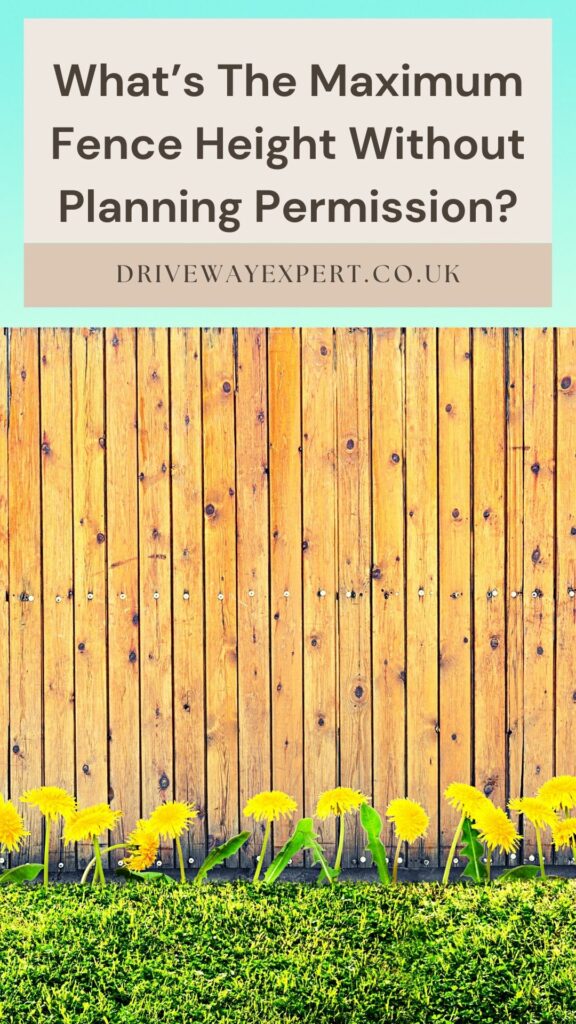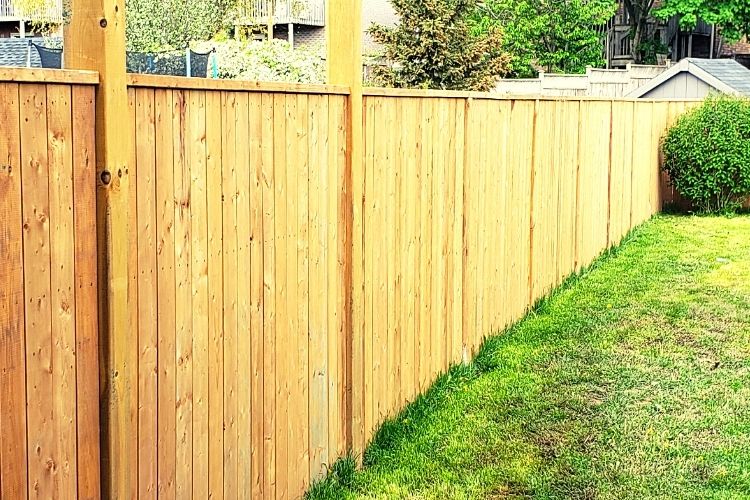If you live in a built up area, having a garden fence affords you some much needed privacy. There are a lot of houses in the UK that share a border with several other properties and it’s not uncommon for other homes to overlook your garden.
Nobody wants to spend a lazy summer afternoon being spied upon by the neighbours, even if it is unintentional. So, installing tall garden fences is often the solution to this problem.
But you have to be very careful when installing a fence in the UK as there are rules and regulations that you have to abide by. One of these involves making sure that your fence does not exceed the maximum height. If you don’t want to mess around with applying for planning permission, it’s vital you stay within these boundaries. But what is the maximum fence height without planning permission?
How high you can have your fence depends on where you are going to place it. If it does not border a public highway then the maximum height is 2 metres. However, if it sits along a public road, you cannot install a fence higher than 1 metre.
However, there are some other things you’ll need to consider when installing a fence on your property. In this guide, we will cover everything you need to know regarding fence height and some other important information.

Table of Contents
How High Can A Fence Be Without Planning Permission?
Most people don’t install garden fences that exceed the permitted height so it typically isn’t a worry. However, you should check to make sure that you are within your rights when installing a new fence and the following rules usually apply.
- If the fence sits next to a public space such as a highway, road or footpath, the fence is not permitted to exceed one metre in height without planning permission.
- If the fence does not sit next to a public space such as a highway, road or footpath, the fence can be up to two metres in height before you need to apply for planning permission.
- For those that live in a Conservation Area, listed building or your property is within the grounds of a listed building, then planning permission is usually required for almost any work including the installation of a fence, regardless of its height.
What About Fences With A Trellis Topper?
You could be forgiven for thinking that the rules for planning permission are in place because too tall fences could block the view. So, if you’re thinking about installing a fence that is shorter than two feet but wish to also install a trellis topper, you might think that this won’t affect whether you need to apply for planning permission.
Using these toppers is a great way to add height to your fence without it being too heavy or in your face. However, there are some legalities you will have to think about before installing this type of fence.
For starters, any fence that exceeds two metres and doesn’t border a public highway must have planning permission even if part of the fence is a trellis topper. This rule applies if the entire structure is more than two metres. If your fence and trellis topper exceeds this measurement then you have to apply for planning permission.
Can I Install A Fence Without Planning Permission?
Most of us choose a regular six foot fence and this can be installed without having to worry about laws or planning. However, it is important to note that some local authorities may have exceptions to this so it’s worth checking with them before doing anything to avoid any complications down the line.
If you are installing a fence and want to make sure that you don’t run into any red tape along the way then follow the golden rule of thumb. If you want to remove an existing fence, post, gate or wall and you own the land, you’re generally allowed to do this without permission. However, as we mentioned earlier, there are exceptions to this rule which largely apply to historical or listed buildings.
You may also install a fence without planning permission if it does not exceed the previously mentioned maximum heights.
Are There Consequences For Not Obtaining Planning Permission For A Fence?
It feels like a lot of hassle to apply for planning permission for something as seemingly innocent as a fence. This is why a lot of people choose to ignore the rules and just put the fence up anyway. In some situations, you may find yourself in a sticky situation because the local authority is well within its rights to ask you to remove the structure if it doesn’t comply with local laws.
If you somehow manage to get away with installing your new fence and nothing happens within four years, it’s highly unlikely that you’ll hear anything after this. This is because the local authority is legally allowed to enforce development rules up to four years after a structure has been built or worked on.
That said, it’s simply not worth wasting your money. If you know that your fence requires planning permission, it’s much easier to apply for this than it would be to receive an enforcement notice.
You might also find that you run into problems with your neighbours if you install an offensive fence without planning permission. If they find out that the fence is erected illegally then a sour neighbour is sure to report this and you’ll be left having to take it down.
We would suggest speaking to your neighbours and discussing your fencing plans with them before carrying out any work. Even in the event that you have obtained planning permission, it’s common courtesy to let them know that work will be taking place. Most people are pretty accommodating of this as long as communication remains open.
So, How Do I Get Planning Permission For A New Fence?
In the UK, you need to contact your Local Planning Authority through your local council. You can find contact details for all of the local councils in the United Kingdom by using the search tool on the government website.
It’s important to note that there is usually a fee when applying for planning permission. But this will likely be far less than paying for one fence, tearing it down, having to apply for permission and then paying for a new fence; as you can see, it’s just not worth ignoring local planning laws, financially speaking.
Are There Any Other Rules I Need To Consider?
It isn’t only planning permission that you’ll need to think about when erecting a new fence. In some cases, you might also need to think about building regulations. This doesn’t apply everywhere but there are some areas in the UK that require you to adhere to these rules.
For the most part, building regulations come into play when dealing with a listed or historic property. Moreover, if you intend to install a fence on land that does not belong to you, you will need to seek express permission from the land owner.
In many cases, homeowners will install fences along boundary lines only to find out that they have encroached on the neighbouring property. Even if this is by mere centimetres, you can be forced to remove the structure.
Conclusion
Having a garden fence is often essential for privacy. While this is something that many of us take for granted, installing a fence might not be as straightforward as you had hoped.
For example, you cannot erect a fence along a public highway that is more than one metre, without planning permission. If you wish to put the fence up in an area of your property that does not sit alongside public space, it can be no more than two metres in height.
There are other things to think about such as exceptions to planning permission, building regulations and potential neighbourly disputes. Before starting a project, we would suggest covering all of these areas to make sure you’re within the confines of the law and aren’t going to upset anyone.


